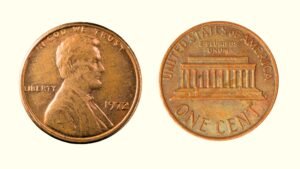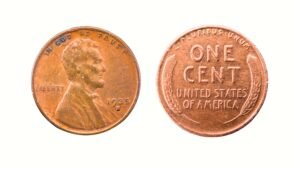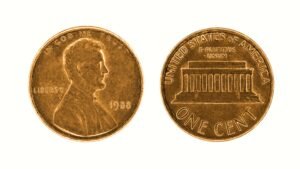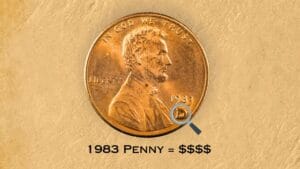The 1960 Lincoln penny may look like an ordinary copper coin at first glance, but it once sold for an eye-popping price of $20,000! Featuring two distinct date varieties, mint errors, and rare features, the 1960 penny attracts much attention due to its high potential value! This article will help determine if your 1960 copper penny is worth big bucks!

1960 Lincoln Memorial Cent History
The 1960 Lincoln Penny marked the second year of the Lincoln Memorial reverse design, which replaced the Wheat Ears design used since 1909 in 1959. Due to high demand, pennies were minted at two different mints in 1960: Philadelphia and Denver.
The most notable feature of the 1960 penny is the Small Date (compact “1960”) and Large Date (spread out “1960”) variety. This occurred because the U.S. Mint used two different sizes for the date on the coin’s obverse.
Due to these varieties and many other rare features and errors discovered on this small cent, the 1960 penny attracts a lot of coin collectors today!
| 1960 Lincoln Memorial Cent | Key Features & Facts |
| Coin Composition | 95% Copper, 5% Tin and Zinc |
| Minting Location | Philadelphia, Denver |
| Minting Year | 1960 |
| Face Value | 1-cent (0.01$) |
| Weight | 3.11 grams |
| Diameter | 19.05 mm |
| Thickness | 1.52 mm |
| Designer | Victor David Brenner, Frank Gasparro |
| Mint Marks | D – Denver Mint, No Mint Mark – Philadelphia Mint |
| Total Mintage | 2,168,980,602 coins |
How to Identify a 1960 Lincoln Penny Design & Composition
Understanding the design and composition of the 1960 Lincoln penny is a crucial step in assessing its value. Here’s how to identify its key features:
1960 Lincoln Penny Obverse:

- A right-facing portrait of Abraham Lincoln
- The motto “IN GOD WE TRUST” above Lincoln’s head along the edge
- The word “LIBERTY” to the left of Lincoln’s bust
- The mint date “1960” at the bottom, below Lincoln’s bust
- The mint mark, if present, below the mint year
Note: Both Philadelphia and Denver Mints produced two varieties of 1960 Lincoln Penny: small date and large date. The large date variety features a taller“9” and “6” than in the small date variety.
1960 Lincoln Penny Reverse:
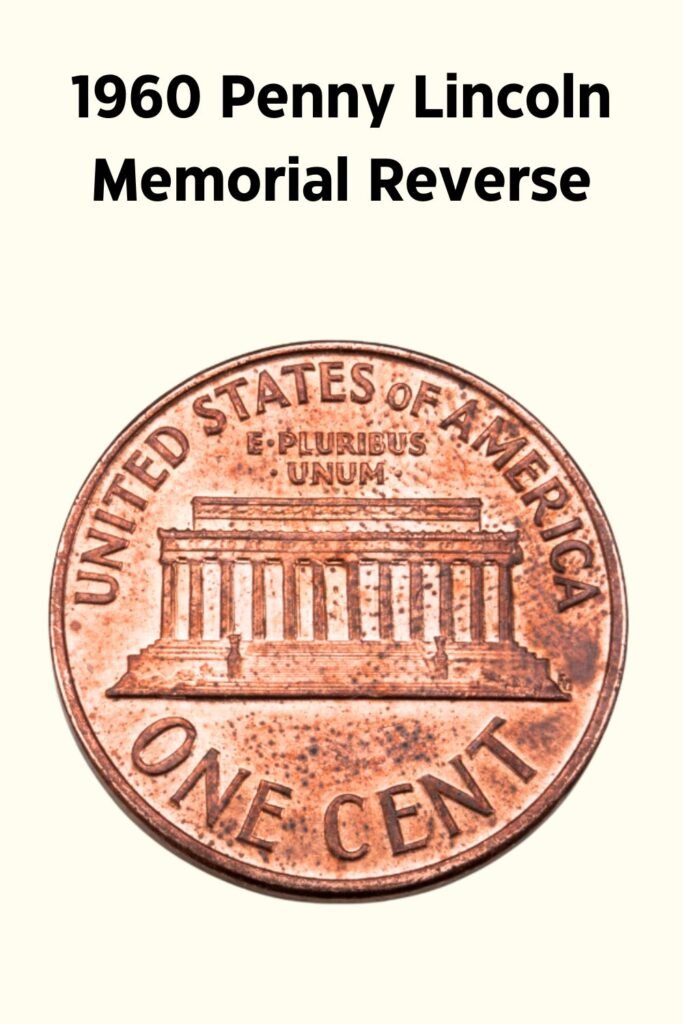
- The depiction of the Lincoln Memorial at the center
- The words “UNITED STATES OF AMERICA” along the top edge
- “E PLURIBUS UNUM” above the Lincoln Memorial
- The denomination “ONE CENT” at the bottom
- The designer, Frank Gasparro’s initials “FG” on the right of the staircase
Coin Composition, Size & Dimensions
The 1960 Lincoln Memorial penny has the traditional bronze composition with 95% copper and 5% tin and zinc. It weighs approximately 3.11 grams (0.110 ounces) and has a diameter of 19.05 millimeters (0.75 inches).
This small cent is 1.52 millimeters (0.059 inches) thick and has a smooth, non-reeded edge, like all Lincoln cents!
Assessing a 1960 Lincoln Penny Value (5 Key Factors)
A typical 1960 Lincoln penny in average condition is worth around 2 to 3 cents. However, uncirculated cents, particularly those in mint state or with rare errors, can fetch values well above $1,000, especially if they feature the Small Date variety.
Let’s understand all the factors that impact a 1960 penny coin value in detail:
1. Coin Grading and Condition
The condition of a 1960 Lincoln Memorial cent is essential in determining its value. Generally, coins are graded on a scale from PO-1 to MS-70; the higher the grades, the better the coin’s condition.
As for the 1960 penny, examples in MS67 and higher grades can fetch decent values ranging from $200 to a few thousand dollars. Lower-grade mint examples are worth $5 to $50, while circulated 1960 cents generally sell for the face value or a few cents more.
2. Coin Toning & Color
The appearance of a 1960 Lincoln penny changes due to oxidation and toning over time, which directly affects its value. Collectors often classify 1960 pennies into three designations based on colors:
- Red (RD): Lincoln pennies with over 95% of their original red luster are graded RD. These are the most desirable 1960 pennies, with uncirculated examples reaching $20 and high-grade examples fetching thousands!
- Red-Brown (RB): Red-Brown pennies display a mix of red and brown hues due to partial oxidation. They are less valuable than pure red coins but can still fetch around $5 to $10.
- Brown (BN): Pennies that have turned completely brown due to oxidation are graded BN and are generally the least valuable. They sell for only a few cents unless they have rare errors or high mint grades.
3. Mint Mark & Mintage (Small Date & Large Date Varieties)
The total mintage for the 1960 Lincoln penny was substantial, with over 2.1 billion coins across different locations. The high mintage makes the coin common, but coins from each mint have different rarity and values.
1960 No Mint Mark Lincoln Penny (Mintage – 586,405,000)
The Philadelphia Mint produced over 586 million 1960 pennies, including both small and large date varieties. However, the exact mintage of both varieties is unknown.
1960 No Mint Mark Penny Small Date
The Small Date variety features a notably smaller and rounder “6” and “9.” It’s generally less common and more valuable. Circulated Small Date 1960 pennies are worth 10 to 50 cents, and uncirculated coins range from $1 to $20. MS-65 or higher grades fetch $20 to $350!
1960 No Mint Mark Penny Large Date
The Large Date variety has a more spread-out date with a larger, more open “6”. Being more common, circulated Large Date 1960 pennies fetch around 25 cents. Uncirculated coins range from 50 cents to $10, with higher grades reaching $200 to $400!
1960 D Lincoln Penny (Mintage – 1,580,884,000)

The Denver Mint also produced both varieties of 1960 pennies with a total mintage of over 1.5 billion coins.
1960 D Penny Small Date
In circulated condition, a Small Date 1960 D penny is worth 10 to 50 cents, while common mint state coins can range from $1 to $20. The value of high-grade examples (MS-67 or above) ranges from $150 to $430.
1960 D Penny Large Date
The value of a circulated Large Date 1960 D Lincoln pennies is around 25 cents. Uncirculated examples can fetch 50 cents to $10, with higher grade fetching up to $500. A rare MS67 Large Date 1960 penny sold for a staggering price of $20,000 on eBay!
4. 1960 Lincoln Penny Proof (Mintage – 1,691,602)
The proof version of the 1960 Lincoln Memorial penny was released at the Philadelphia Mint, which means they have no mint mark. You can identify them by their sharp details and mirror-like surfaces.
The 1960 Lincoln penny proof coins are also available in Small Date and Large Date varieties. Generally both varieties are worth $3 to $5 in PR-63 grade, while higher grades like PR-65 and PR-67 or above sell for $5 to $30.
The value of 1960 penny proof coins also depends on three types of proof finishes:
- Regular PR Proofs: Regular 1960 proof cents display the standard proof finish with a mirror-like surface. These coins are typically worth $10 to $20.
- Cameo (CAM) Proofs: Cameo proof coins are identified by a strong contrast between frosted designs and mirrored backgrounds. A PR-65 Cameo might be valued at $20 to $40, while a PR-70 example can sell for as much as $4,000!
- Deep Cameo (DCAM) Proofs: These penny-proof coins feature a sharper contrast between raised devices and mirror-like surfaces. DCAM 1960 Lincoln penny coins are worth the most, with the highest PR-69 examples fetching up to $3,000, this small date version that sold for $2,990 on Heritage Auctions!
5. Rare 1960 Lincoln Penny Errors List
Minting errors can greatly enhance the value of a 1960 Lincoln penny. Here are the most valuable 1960 penny errors to find:
Double Die Obverse (DDO)
To spot a Double Die Obverse 1960 Penny, look for a doubling on the obverse, particularly in the lettering of “LIBERTY,” the date, and the mint mark, if present. The value of a DDO 1960 penny ranges from $50 to $400, depending on the coin’s condition and variety.
1960 D/D RPM Small Over Large Date Penny
This is a Repunched Mint Mark (RPM) error combined with an overpunched date size variety, in which the Small Date variety is punched on the Large Date variety. These error coins can be significantly valuable, fetching $100 to $300 in common mint grades, with higher grades fetching $1,000 to $2,500 or more!
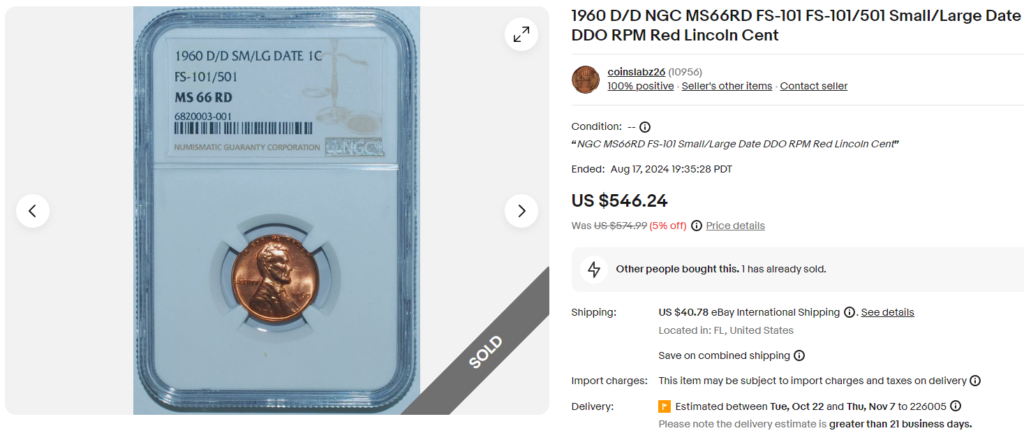
Struck on a Silver Dime Planchet
The 1960 Lincoln penny struck on a silver dime planchet is a rare error coin, which is produced when a penny is mistakenly struck on a silver dime planchet, which was composed of 90% silver and 10% copper prior to 1965. The color of this coin will be gray instead of red or brown. An MS61 example of this rare coin sold for $940 on Heritage Auctions!
Apart from this, you may also find the 1960 Lincoln Cent with common errors like clipped planchet error, off-center errors, and die cut or die break errors, which can be valuable.
Generally, a 1960 Lincoln Penny only fetches higher returns if it has a rare mint mark, is in excellent condition, or has one of the rare errors listed above. So, make sure to analyze your 1960 penny’s features using this guide to find its real value!
Note: This article is intended for informational, educational, and entertainment purposes only. Some images are illustrative and may not represent actual brands, products, or related entities. All trademarks, product names, brand logos, packaging, and other intellectual property referenced remain the exclusive property of their respective owners. Any brand mentions or references are provided solely for descriptive and educational context and do not imply any formal or commercial association.

